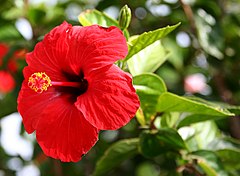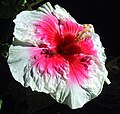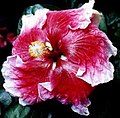Hibiscus rosa-sinensis
| Hibiscus osa-sinensis subsp. var. | Chinese Hibiscus, China rose, shoe flower | |||||||||||||||||||||||||||||||||||||||||||||||||||||||
|---|---|---|---|---|---|---|---|---|---|---|---|---|---|---|---|---|---|---|---|---|---|---|---|---|---|---|---|---|---|---|---|---|---|---|---|---|---|---|---|---|---|---|---|---|---|---|---|---|---|---|---|---|---|---|---|---|

|
|
| ||||||||||||||||||||||||||||||||||||||||||||||||||||||
| ||||||||||||||||||||||||||||||||||||||||||||||||||||||||
Hibiscus rosa-sinensis, known colloquially as the Chinese hibiscus, China rose and shoe flower, is an evergreen flowering shrub native to East Asia.
It is widely grown as an ornamental plant throughout the tropics and subtropics. The flowers are large, generally red in the original varieties, and firm, but generally lack any scent. Numerous varieties, cultivars, and hybrids are available, with flower colors ranging from white through yellow and orange to scarlet and shades of pink, with both single and double sets of petals. The flowers themselves are edible and are used in salads in the Pacific Islands.
An evergreen Shrub growing to 2.5m by 2.5m. It is hardy to zone 9 and is frost tender. It is in leaf all year. The flowers are hermaphrodite (have both male and female organs) and are pollinated by Insects.pf
| Standard Cyclopedia of Horticulture |
|---|
|
Hibiscus rosa-sinensis, Linn. (H. sinensis, Hort.). Chinese Hibiscus. Fig. 1834. In glasshouses a shrub 3-8 ft. high, but reaching 30 ft. in subtropical regions and becoming tree-like: glabrous: lvs. rather large, thin and shining green, broad-ovate to lance-ovate, somewhat tapering to the base, acuminate, coarsely and unequally toothed: bracteoles linear, free, as long as the calyx: fls. solitary in the upper axils of the new growth, on peduncles which exceed the petioles, bright rose-red, 4-5 in. across, with a projecting red column of stamens and pistil; sepals lanceolate, joined below the middle: caps, ovoid, glabrous, the valves terminating in a short beak. Asia, probably China: now distributed in warm countries, and one of the best known old- fashioned conservatory pot-plants, and one of the characteristic plants in tropical countries.—It is now immensely variable. Forms are double-fld., and others are orange, yellow, bright red, magenta, and parti-colored. Var. Cooperi, Hort. (H. cooperi, Hort.), has narrow white- marked lvs. and distorted scarlet fls. Var. Calleri, Hort. Fls. buff-yellow with crimson-scarlet base. Var. Van Houttei, Hort., deep crimson. Trade names belonging to H. Rosa-sinensis are brilliantissimus; carminatus, chrysanthus; fulgidus, fulgens; kermesinus; luteolus; luteus; miniatus; splendens; sub-violaceus; zebrinus. H. rosa-sinensis is a summer- flowering shrub which always attracts attention. It is often plunged in the open with other subtropical stuff. It is easy to grow in ordinary potting soil. In winter keep it slow by withholding water and keeping in a temperature not above 50°. In spring head the plants in and start them up to get the new wood on which the fls. are borne. Give plenty of water when growing, and syringe frequently. Prop, readily by softwood cuttings in spring, or by hard cuttings in fall. The fls. of this plant are said to be used in some places for dyeing hair and also for blacking shoes, whence the name "shoeblack plant." The species seldom seeds in cultivation, although it is reported seeding freely in tropical regions.
|
Cultivation
The plant prefers light (sandy), medium (loamy) and heavy (clay) soils and requires well-drained soil. The plant prefers acid, neutral and basic (alkaline) soils. It cannot grow in the shade. It requires moist soil.
Prefers a well-drained humus rich fertile soil in a warm, sheltered position in full sun[200, 260]. A very ornamental plant[1], it is not very frost-tolerant and needs to be grown in essentially frost-free areas. It might succeed outdoors in the very mildest areas of the country if given a very sheltered warm position. Alternatively, it might be possible to grow the plant as a tender annual by starting it off early in a warm greenhouse. If well-grown it can flower and set seed in its first year. This species grows very well in a frost-free conservatory in Northern Europe so long as it is in a sunny position and free from draughts[260]. Plants will often lose most of their leaves in cool winters, though they will normally regenerate quickly as the warmer weather returns[260]. The flowers of Chinese hibiscus are very important in Hindu devotional ceremonies, being sacred to the Elephant God, Ganesh[238]. Individual flowers are short-lived, in many modern cultivars the flowers wither after 24 hours though in many of the older cultivars they can last for 48 hours[260]. There are many named forms, selected for their ornamental value[200].
Propagation
Seed - sow early spring in a warm greenhouse. Germination is usually fairly rapid. Prick out the seedlings into individual pots when they are large enough to handle. If growing them as annuals, plant them out into their permanent positions in early summer and protect them with a frame or cloche until they are growing away well. If hoping to grow them as perennials, then it is better to grow them on in the greenhouse for their first year and to plant them out in early summer of the following year. Cuttings of half-ripe wood, July/August in a frame. Overwinter them in a warm greenhouse and plant out after the last expected frosts.
Pests and diseases
aphids, thrips, whiteflies and spider mites
Varieties
- 'Cooperi' - At about 10cm across, the flowers are smaller than most cultivars, but the plant is quite compact and thus suitable for pot culture[260].
- 'Diamond Head' - A compact form, and thus suitable for pot culture, it produces double flowers about 15cm across over a long season[260].
- 'Florida Sunset' - A compact form that grows well in containers, the flowers at 10cm in diameter are smaller than most other cultivars[260].
- 'Hula Girl' - A very free-flowering form, the flowers are up to 16cm in diameter[260].
- 'Lady Bird' - An upright form of average height, the flowers are up to 20cm across and are larger than most other cultivars[260].
- 'Norman Lee' - A vigorous variety of medium height, it blooms profusely producing flowers up to 20cm across[260].
- 'White Wings' - Its compact habit makes this form a good candidate for pot cultivation. It produces large white flowers to 15cm across and is frequently used for hedging in tropical climates[260].
- Example – two crosses of 'King Kalakua' and 'Mystic Pink'
The photographs in the gallery above show the flowers from the pollen parent, the pod parent, and two offspring of a cross as described, which demonstrate virtually no color characteristics of the parent plants, and few of the physical characteristics.
Gallery
References
- Plants for a Future - creative commons text incorporated
- Standard Cyclopedia of Horticulture, by L. H. Bailey, MacMillan Co., 1963
External links
- w:Hibiscus rosa-sinensis. Some of the material on this page may be from Wikipedia, under the Creative Commons license.
- Hibiscus rosa-sinensis QR Code (Size 50, 100, 200, 500)











